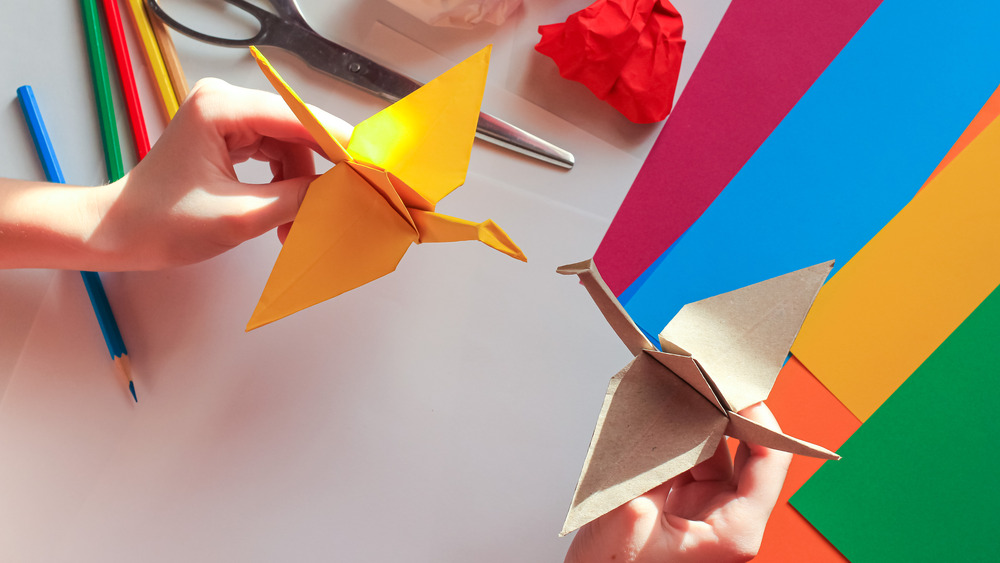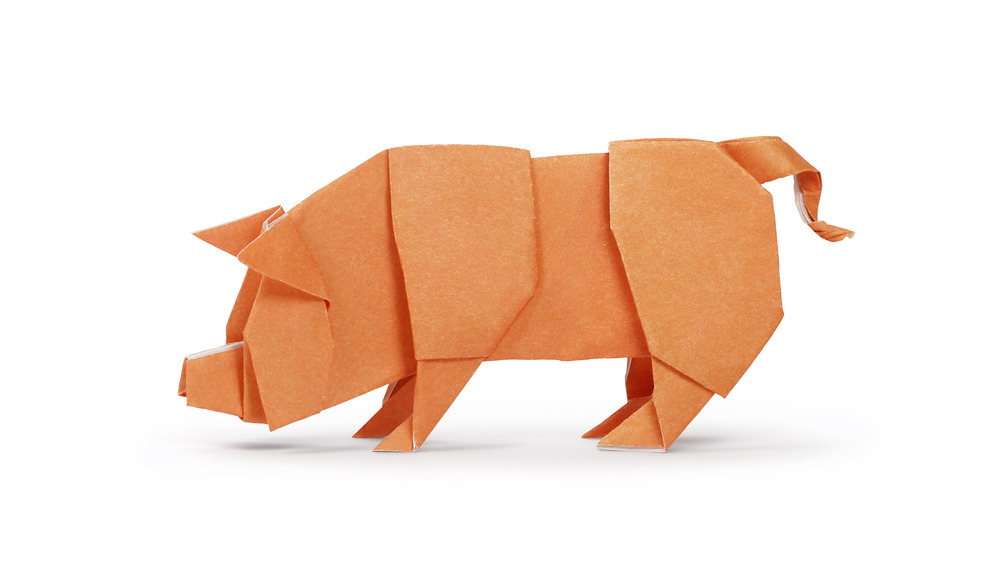The Fascinating History Of Japanese Origami
In 2021, a team of researchers at Cornell University successfully folded the world's tiniest origami bird, at about 100 microns wide (one percent of one centimeter), as outlined on Sci News. They did it using microscopic, "shape memory" conductors, countable atoms thick, that jolt nigh-2D materials into 3D shapes. Strictly speaking, it's a robot, and one that Professor Itai Cohen and his team hope presages future nanotechnology. And on the handmade side, we've got the paper-folding skills of tiny origami masters such as this one on YouTube, whose crane measures a mere three or four millimeters wide.
Origami has become a worldwide hobby of the crafty, whether a young adult is alleviating boredom in school, an industrious parent is building DIY art projects such as those on Artsycraftymom, or an office-dweller has lined up a row of colorful, paper animals along their desk. Origami has a low initial cost for entry — only the paper — and can be finished, barring creative excursions, by following instructions found in any of dozens of books about paper-folding. Undoubtedly, this is part of the reason for origami's appeal, much like old paper airplanes.
But where exactly did origami come from? The short answer is: Japan. A combination of the verb oru (to fold) and kami (paper), the term "origami" has entered the Western lexicon as surely as other Japanese words like karaoke, sushi, tofu, gyoza, tsunami, shogun, karate, emoji, futon, sudoku, and tycoon (yes, it's a Japanese word: taikun).
An international art form popularized after World War II
"When your hands are busy, your heart is serene."
Such were the words of "origami master" Akira Yoshizawa, who passed away in 2005 at the age of 94 after living a life as Japan's "global ambassador" of origami, per the Japan Times. He had first become interested in paper folding at the age of three, by all accounts, and after World War II worked odd jobs while continuing his craft. By the time the 1950s rolled around, he caught the attention of anthropologists and the international art community, which effectively helped to legitimize origami as an art form. Kiyo, his wife of 45 years, said, "At first people only thought of origami as entertainment for children. Gradually, it won acceptance." Now, we've got full-on origami exhibits such as those at the Origami Art Museum, origami materials and workshop hubs such as Origami Kaikan, and high-end, completed origami shops such as Origami House.
Long before the present, though — at least since Japan's Heian era (794-1185 CE) — origami shows up in narratives, such as when famed astrologer and priest Abe no Seimei claimed to have transformed a paper bird into a real one (per K's Origami). During the Edo period (1603-1887), the art became codified and took on the name orisue or orikata ("folded form"). By the time the modernization of the Meiji Era (1868-1912) came and left, it had transitioned from orimono ("folded thing") to its current name, origami.
A hobby of nobility turned into a hobby of the masses
The Japanese culture blog Toki ("crested ibis") discusses how origami might have arrived in Japan through China through Buddhist monks in the sixth century, much like Japan's complex, syllabic writing system kanji. Heian-era nobles considered it a kind of leisurely, elegant hobby, particularly for use in gift-wrapping. The paper itself was often patterned or stenciled. Beautified paper gift-wrapping is still very much a thing Japan, as evidenced by male-female butterfly origami used to wrap sake as wedding gifts, per Inside Japan.
Of course, the exact lineage of origami is tough to trace, as paper disintegrates. At minimum, come the Edo era, we have the first mention of origami in literature in 1680, through poet Ihara Saikaku (1642-1693) and his poem "Rosei ga yume no cho wa orisue" — "The Fragile Dream of the Origami Butterfly" (best-fit translation). Origami spread throughout various classes, including samurai, and by 1764 we have the first historical evidence of an origami instructional book. Around this time ukiyo-e — Japanese woodblock art — was in full bloom, and widespread art materials led to the development of origami-like dragonflies, stars, frogs, and helmets.
Origami was never limited only to Japan, though. Evidence suggests that paper folding rose in Europe either independently or in tandem with Dutch traders who regularly visited Japan starting in the 17th century. John Webster's 1613 play The Duchess of Malfi, for instance, talks of children using "paper prisons" to capture insects.


